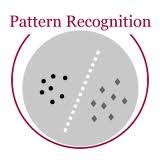Augmented reality applications are beginning to change the way sports are broadcast, providing richer experiences and valuable insights to fans. The first step of augmented reality systems is camera calibration, possibly based on detecting the line markings of the playing field. Most existing proposals for line detection rely on edge detection and Hough transform, but radial distortion and extraneous edges cause inaccurate or spurious detections of line markings. We propose a novel strategy to automatically and accurately segment and classify line markings. First, line points are segmented thanks to a stochastic watershed transform that is robust to radial distortions, since it makes no assumptions about line straightness, and is unaffected by the presence of players or the ball. The line points are then linked to primitive structures (straight lines and ellipses) thanks to a very efficient procedure that makes no assumptions about the number of primitives that appear in each image. The strategy has been tested on a new and public database composed by 60 annotated images from matches in five stadiums. The results obtained have proven that the proposed strategy is more robust and accurate than existing approaches, achieving successful line mark detection even in challenging conditions.
翻译:强化的现实应用正在开始改变体育的广播方式,为球迷提供更丰富的经验和宝贵的洞察力。强化的现实系统的第一步是摄像机校准,可能以探测比赛场的线标志为基础。大部分现有的线探测建议依赖于边缘探测和Hough变形,但辐射扭曲和外部边缘导致线标记的不准确或虚假的探测。我们提出了一个新的战略,以自动和准确的分块和分划线标记。首先,线点由于对辐射扭曲的强大分水岭变形而被分割,因为它没有对线直线的假设,并且不受球员或球的出现的影响。线点随后与原始结构(直线和椭圆)相连,因为一个非常有效的程序,对每张图像中显示的原始数没有作出假设。我们提出的战略是在一个新的公共数据库中测试,由五个体育场匹配的60张附加说明的图像组成。取得的结果证明,拟议的战略比现有方法更加健全和准确,即使在具有挑战的条件下也取得了成功的分线标记。




